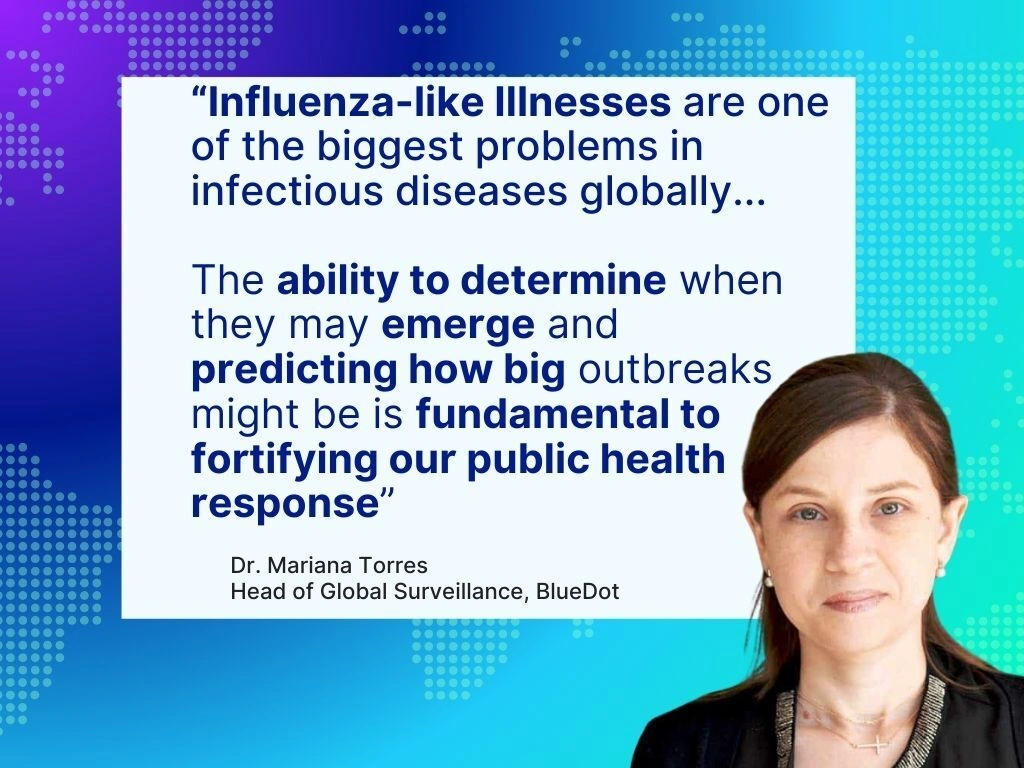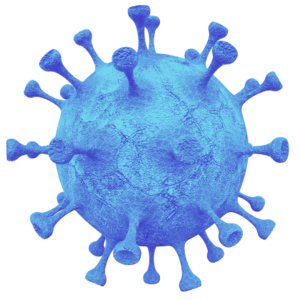The first quarter of 2025 paints a worrying picture of measles cases around the world
In the years since the SARS-CoV-2 virus emerged and devastated health systems globally, another virus has made a resurgence: measles. One of the most contagious infectious diseases known to science, measles has resulted in outbreaks across all regions in the last few years, leading public health experts to sound the alarm.
Approximately 80,000 cases have been reported so far this year in the Western Pacific Region, comprising the majority of cases worldwide. The African and Eastern Mediterranean regions have both surpassed 20,000 cases, while Europe has exceeded 10,000 cases as the region faces a tenfold increase over last year. And measles continues to surge and cross borders in North America, leaving experts increasingly more concerned about an impending explosion of cases in South America, where vaccine coverage is generally much lower.
Disruptions in vaccine supply and distribution amid the chaos caused by the COVID-19 pandemic have led to declines in vaccination coverage. Since then, efforts to fill the immunization gap have been impaired as vaccine hesitancy has grown, leading all regions to fall below the 95% immunization threshold needed to prevent outbreaks. Now, several nations that had eliminated measles, including the US, Canada, Australia and the Philippines, are at-risk of losing their measles-free status.
As measles outbreaks apply increasing pressure on health systems, public health measures to control the spread are struggling to keep up. “It’s like whack-a-mole — we are seeing cases flare up in one country, and just as it’s getting under control, we have cases flare up in another,” says Andrea Thomas, PhD, BlueDot’s head of epidemiology. “This could be a decade-long problem that is likely to get worse before it gets better.”
Measles multiplies worldwide
Endemic to many nations around the globe, measles is a highly contagious viral respiratory illness. Nine in 10 unvaccinated people will contract measles if they are exposed to one infected person. Symptoms can range in severity and may result in life-threatening complications, such as pneumonia and encephalitis, in more severe cases. There is no cure.
The current measles outbreak presents an unabating global threat. In the first four months of 2025, there has been an 11-fold increase in measles compared with the same period in 2024. The virus has been detected in every region worldwide, underscoring wider geographic spread. The highest rates so far this year have been detected in the Western Pacific Region, with nearly 80,000 total cases. This spike is primarily occurring in Vietnam, which has seen more than 76,000 cases. Lower but nevertheless concerning rates have been reported in Africa and the Eastern Mediterranean, with more than 20,000 cases each. Europe is following, with more than 10,000 cases.
Compared to the same time period last year, an increase in total measles cases has been reported in three regions: Western Pacific, South-East Asia, and the Americas. The massive outbreaks in Vietnam and India have led to importation in nearby Cambodia, Thailand, the Philippines, Japan, and South Korea, driving up total measles cases in the Western Pacific and South-East Asian regions. Despite lower rates in North America, cases in the US and Mexico have both exceeded 1,000 cases, and Canada is approaching 2,000 cases.
Total Measles Cases Between January and April by WHO Region, 2024 and 2025
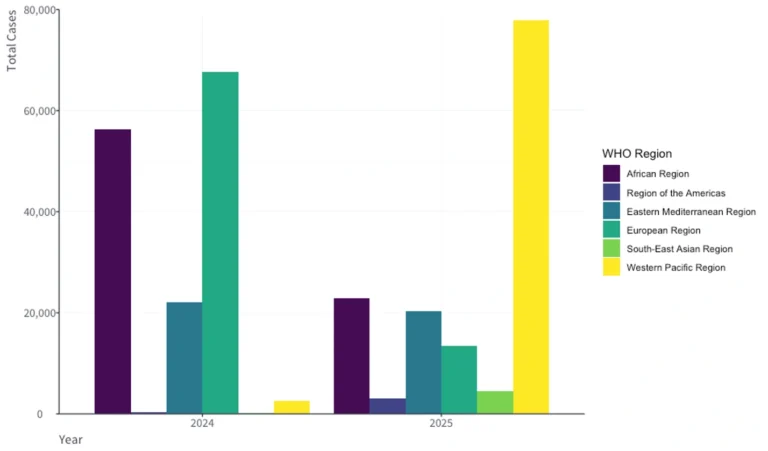
Source: BlueDot, May 16, 2025.
Before the COVID-19 pandemic struck, all WHO regions reported measles cases. By 2020, case counts had decreased as public health measures to control coronavirus disease transmission also prevented outbreaks of other respiratory infectious diseases. But since 2022, almost every region has met or exceeded pre-pandemic levels.
Estimated case counts for 2023 represented a 20% increase from the year prior, with outbreaks reported across 57 countries, a nearly 60% increase from the 36 countries in 2022. Global measles cases increased 18% and associated deaths increased 43% in 2022 compared to 2021.
By 2024, measles outbreaks had continued worldwide, with cases reported across more than 180 WHO member states. Accounting for one-third of all global measles cases and driving the increase was the European Region, which reported 127,350 cases — a 27-year high and double the rates from 2023. Every region except for the South-East Asian Region saw measles increase between 2023 and 2024.
Over time, outbreaks have resulted from both locally-acquired and imported cases, marking a shift for some countries that had eliminated measles and only saw travel-associated cases. Still, measles is likely underreported as symptoms can be mild and may mimic other infectious diseases, such as dengue, rubella, and enterovirus diseases such as hand, foot and mouth.
Total Measles Cases Between 2018 and 2024 by WHO Region
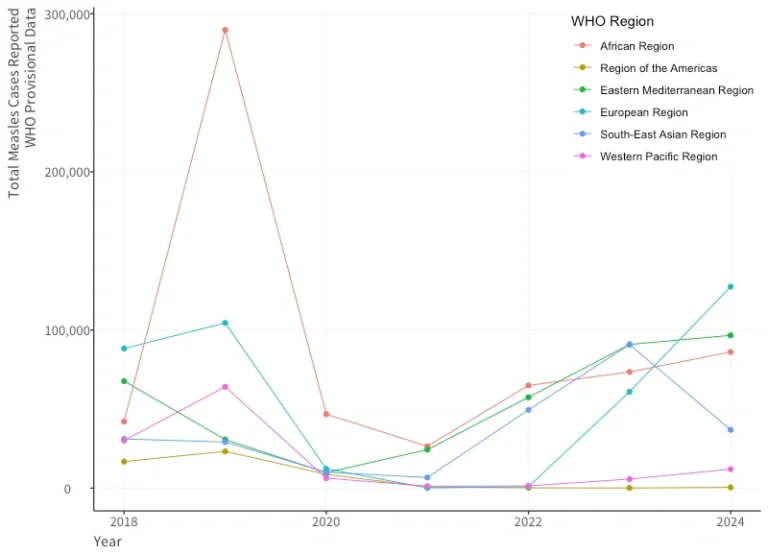
Source: BlueDot, March 14, 2025.
3 Top Takeaways
- Measles resurgence continues globally. Every region around the globe has reported measles cases so far this year, with most cases in the Western Pacific Region as cases hit 80,000. The resurgence shows no signs of slowing down, and experts warn that outbreaks could persist for years.
- Low vaccine coverage raises risk. Global measles vaccine coverage in 2023 fell below 85%, and no global region has recovered to its pre-pandemic levels of measles-containing vaccine coverage for both required doses. Consequently, many are at-risk for measles infection.
- Measles disease burden is immense. Patient, healthcare system, and societal burden of measles is extensive. But vaccination is highly effective, affordable, and offers an estimated 44-fold return on investment.
Growing gaps in measles immunization
Outbreaks around the globe are largely attributable to declining vaccination coverage. As the COVID-19 pandemic ensued, routine immunization decreased. Over 61 million measles vaccine doses were postponed or missed between 2020 and 2022, a 20% drop in vaccinations. Left in the pandemic’s wake was vaccine misinformation and increased hesitancy. And once travel restrictions were lifted, millions of people became increasingly more susceptible to exposure.
As of 2023, the latest available data for global vaccine coverage, just 83% received their first dose and 74% received their second dose of the measles vaccine. Europe is the only region that met the 95% threshold for herd immunity. Between 2018 and 2023, first dose coverage declined in every region except for the European and African regions, which held steady at 95% and 70%, respectively. Notably, the Americas saw the largest decrease in vaccination, declining from 91% in 2018 to 85% in 2023.
Second-dose coverage is even further below the recommended threshold in every region. The Americas, Eastern Mediterranean, and African regions have less than 80% coverage. Unlike the latter two regions, which remained steady and increased in coverage, respectively, the Americas saw a 9% reduction in coverage between 2018 and 2023. Taken together, a sizable percentage of the population are unvaccinated or partially vaccinated, and experts fear the virus will reach communities with low vaccination rates.
Total Percent Vaccine Coverage Between 2018 and 2023 by WHO Regions (A) and the African Region (B)
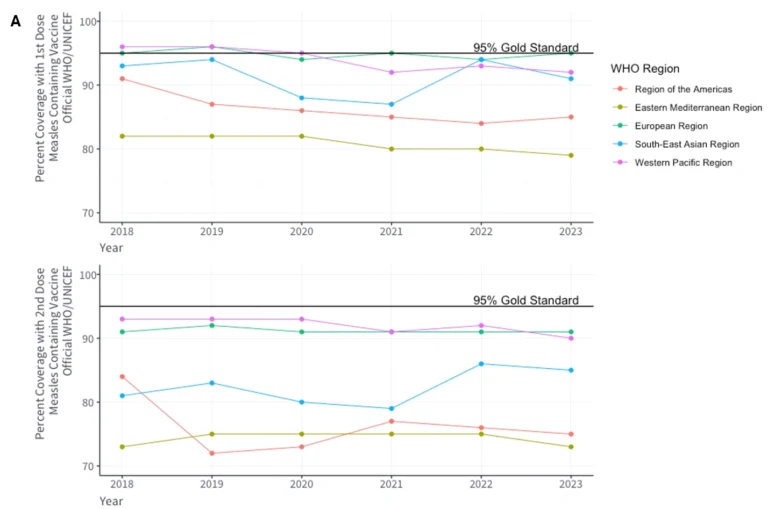
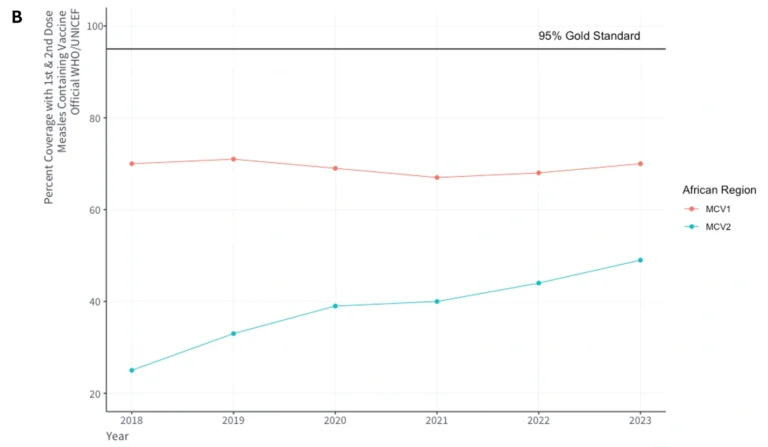
Note: The African region is plotted separately due to its wider range in vaccination coverage values compared to other regions.
Source: BlueDot, March 14, 2025.
In some regions, access to and distribution of vaccines is particularly challenging. For instance, many countries in the African and Eastern Mediterranean regions are navigating conflict and humanitarian crises, which cause population displacement, hinder immunization programs, and disrupt health services. This is also a concern in Ukraine, which has seen a 20.5-fold increase in cases from last year.
Although the MMR vaccine is 97% effective in protecting against measles and has prevented approximately 60 million deaths between 2000 and 2023, immunization rates are too low in many locations to prevent outbreaks. Declines in vaccination also mean we are likely to see increases in mumps and rubella, which are usually part of the same childhood vaccine. The Immunization Agenda 2030, which aims to eliminate measles around the globe, must overcome significant barriers if this goal is to be realized.
Ramifications of measles’ ongoing resurgence
Measles continues to be a major public health challenge, leading to serious infection and claiming the lives of more than 100,000 people every year. However, the risk of severe illness and death extends far beyond the acute infection.
Some patients may experience long-term or lifelong health effects associated with complications, such as blindness or brain damage. “Immune amnesia,” a phenomenon whereby immune system memory is reset, can also result from measles infection. It can take up to three years post infection before immune systems can be restored, rendering individuals more vulnerable to other infectious diseases.
From diagnostic testing to contact tracing and hospitalization, measles is also associated with substantial healthcare resource utilization and economic burden. For example, the total cost of measles hospitalization in the US between 2002 and 2016 was nearly $17 million. Beyond direct medical costs, societal costs are extensive. In an analysis of the 2019 Clark County outbreak in the US, $2.3 million was attributable to the public health response, and $1 million was associated with productivity loss.
Measles prevention is paramount to reduce long-term health risks and costs. Fortunately, the vaccine is highly effective and inexpensive, and investing in the measles vaccination has demonstrated substantial economic benefit, with an estimated 44-fold return on investment. Between 1994 and 2023, routine childhood vaccinations prevented an estimated 32 million hospitalizations, 1.1 million deaths, and led to $540 billion in direct cost savings and $2.7 trillion in societal cost savings in the US.
Reversing the rise in measles will require strengthened vaccine confidence, ongoing or increased access to vaccines, and increased vaccination rates. “With no animal host and a very effective vaccine, measles is theoretically a disease we can eliminate,” says Thomas. “But with widespread outbreaks, barriers to prevent herd immunity, and growing vaccine hesitancy, measles presents a significant public health challenge needing global effort.”
On our radar
- Meningococcal disease in Vietnam: Between January and April, 12 cases of meningococcal disease have been reported in Ho Chi Minh City, marking a threefold increase compared to last year. The bacterial respiratory infection has been reported across Southern Vietnam, with increased risk in crowded living conditions, such as dormitories and barracks. Given the disease can rapidly progress in severity, including convulsions, septic shock, and multi-organ failure, there is a need for early diagnosis and for vaccinations to be increased.
- Anthrax in Thailand: On May 1, the first fatal case of gastrointestinal anthrax in nearly a decade was reported by health authorities. The bacterial infection was linked to handling and eating undercooked beef associated with a religious ceremony. Public health measures were immediately implemented, with approximately 250 people being monitored and antibiotics being distributed, as well as livestock monitoring and vaccination campaigns.
- MERS in Saudi Arabia: Between March 1 and April 21, nine laboratory-confirmed cases and two deaths of Middle East Respiratory Syndrome coronavirus (MERS-CoV) were reported. A cluster in Riyadh had hospital-acquired infections linked to an index patient, although several other cases did not have contact with camels — the primary animal reservoir — suggesting human transmission. With the Hajj rapidly approaching, there is a risk for travel-related exportation of cases of this disease, which lacks a vaccine or specific treatment.
BlueDot will continue to monitor global measles outbreaks closely. To receive global and local outbreak intelligence, sign up here to receive every edition of BlueDot’s biweekly newsletter, Outbreak Insider.


